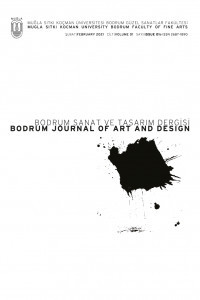Tasarımın Genişleyen Etki Alanları ve Türkiye’deki Endüstriyel Tasarım Eğitiminin Bu Kapsamda İncelenmesi
Teknolojik gelişmeler ile birlikte tasarım anlayışı ve pratiği de zamanla değişmiş, faaliyet alanı genişlemiş ve çeşitlenmiştir. Tasarımcılar sınırları belirli olmayan, karmaşık toplumsal ve çevresel problemlere çözümler üretebilmek için alışageldikleri ürün tasarımı yeteneklerinin ötesinde bilgi ve becerilere ihtiyaç duymuşlardır. Bu kapsamda tasarımcının rolleri değişmiş, yeni alt disiplinler ve tasarım yöntemleri ortaya çıkmıştır. Tasarım alanına eklenen ve gün geçtikçe artan bilgi ve yeteneklerin takip edilmesi ve endüstriyel tasarım eğitiminin bu değişiklikler doğrultusunda güncellenmesi önemlidir. Bu araştırmada Türkiye’deki endüstriyel tasarım bölümlerindeki eğitimin kapsamı ve mevcut durumu incelenmiş ve sistemli olarak analizlerinin yapılması amacıyla Buchanan’ın tasarımın dört seviyesi çerçevesinden yararlanılmıştır. Türkiye’deki 26 üniversitenin endüstriyel tasarım bölüm başkanlarıyla iletişime geçilmiş ve çevrimiçi olarak paylaşılan anketi bölümlerinde verilen eğitimi değerlendirerek doldurmaları istenmiştir. Toplamda 18 bölüm başkanı anket araştırmasına katılmıştır. Anket safhasından elde edilen veriler, sonuçları doğrulamak amacıyla; bölümlerin internet sayfalarında paylaşılan ders programları, ders katalog formları ve bölümle ilgili akademik yayınlarla mukayese edilerek bir analiz oluşturulmuştur. Araştırma sonuçları, ürün tasarımı projeleri ve yetkinliklerine ek olarak hizmet tasarımı, kurumsal ve bölgesel tasarım, sosyal sorumluluk için tasarım gibi daha soyut ve bütünleşik projelerin ve yöntemlerin de uygulanmaya başladığını göstermiştir. Sonuçlar Türkiye’deki endüstriyel tasarım eğitiminin günümüzdeki durumunu ve yönelimini özetler niteliktedir.
Anahtar Kelimeler:
Endüstriyel Tasarım, Ürün Tasarımı, Tasarım Eğitimi, Tasarımın Dört Seviyesi
Extending Areas of Design and Investigating Industrial Design Education in Turkey within This Context
Along with the technological developments, the understanding and practice of design have also changed over time, and the field of its activity has expanded and diversified. Designers needed knowledge and skills beyond their usual product design skills to produce solutions to complex social and environmental problems with unclear boundaries. In this context, the roles of the designer have changed; new sub-disciplines and design methods have emerged. It is important to follow the increasing knowledge and skills in the field of design and to update educational content in line with these changes. In this research, the scope and current state of industrial design education in Turkey were examined, and Buchanan’s “four orders of design” was used to offer a systematic analysis. The heads of industrial design departments of 26 universities were contacted and they were asked to fill out an online survey evaluating the design education in their departments. A total of 18 department heads participated in the survey. To verify the data obtained from the survey, curriculums, course descriptions, and academic publications were compared, and an analysis was carried out. Research results revealed that in addition to product design projects and competencies, more abstract and integrated projects and subjects such as service design, corporate and regional design, and design for social responsibility began to be implemented. The research results summarize the current state and trend of industrial design education in Turkey.
Keywords:
Industrial Design, Product Design, Design Education, Four Orders of Design,
___
- Buchanan, R. (1992). Wicked problems in design thinking. Design Issues, 8(2), 5-21. https://doi.org/10.2307/1511637
- Buchanan, R. (1998). Branzis dilemma: Design in contemporary culture. Design Issues, 14(1), 3-20. https://doi.org/10.2307/1511825
- Buchanan, R. (2001). Design research and the new learning. Design Issues, 17(4), 3-23. https://doi.org/10.1162/07479360152681056
- Buchanan, R. (2008). Introduction: Design and organizational change. Design Issues, 24(1), 2-9. https://doi.org/10.1162/desi.2008.24.1.2
- Buchanan, R. (2019). Surroundings and environments in fourth order design. Design Issues, 35(1), 422. https://doi.org/10.1162/desi_a_00517
- Cizrelioğlu Karaer, F. (2011). Türkiye endüstriyel tasarım yazını üzerine bir inceleme: 1971-2009 arası akademik çalışmaların analizi [Yayınlanmamış yüksek lisans tezi. İstanbul Teknik Üniversitesi, Fen Bilimleri Enstitüsü, İstanbul].
- World Design Organization. (t.y.). Definition of industrial design. World Design Organization. https://wdo.org/about/definition/ (15.07.2019).
- Dubberly, H. (2018, January 19). Connecting things: Broadening design to include systems, platforms, and product-service ecologies. Dubberly Design Office. http://www.dubberly.com/articles/connecting-things.html (12.12.2018).
- Enşici, A. (t.y.). Türkiye’de endüstriyel tasarım eğitimi. Panorama Khas. http://panorama.khas.edu.tr/turkiyede-endustriyel-tasarim-egitimi-24 (10.07.2019).
- Er, Ö. ve Er, H. A. (2006). Design research in the periphery: A review of the foundations and development characteristics of industrial design research in Turkey. ITU A|Z, 3(1), 85-97.
- Findeli, A. (2001). Rethinking design education for the 21st century: Theoretical, methodological, and ethical discussion. Design Issues,17(1), 5-17. https://doi.org/10.1162/07479360152103796
- World Design Organization. (t.y.). Industrial design definition history. World Design Organization. http://wdo.org/about/definition/industrial-design-definition-history/ (15.07.2019).
- Tezel, E. (2011). Industrial design in Turkey: A historical segmentation in policy, industry and design. Intercultural Understanding, 1, 99-103.
- Kiernan, L. & Ledwith, A. (2014). Is design education preparing product designers for the real world? A study of product design graduates in Ireland. The Design Journal, 17(2), 218-237. https://doi.org/10.2752/175630614X13915240576022
- Kolko, J. (2005). New Techniques in Industrial Design Education. In 6th International Conference of the European Academy of Design Proceedings. http://www.jonkolko.com/writingNewTechniques.php (02.01.2021).
- Norman, D. (2011). The problem with design education in Technology Review. MIT Press, Cambridge. https://www.technologyreview.com/s/423552/the-problem-with-design-education/ (08.08.2019).
- Obasuyi, O., Efer, F. (2017). Industrial Design and Contextualism: The Applied Arts Constituent/ Curriculum Imperatives in Design Practice and Education. Review of Artistic Education, 14(1), 249-261. https://doi.org/10.1515/rae-2017-0031
- Raduma, W. (2011). Occupy reimagining design. The ReReThinking Series.
- Roald, J. (2006). Design leadership. 5th Nordcode Seminar: Connecting Fields, Oslo, May 10-12.
- Ryan, A., Leung, M. (2014). Systemic design: Two Canadian case studies. FORMakademisk, 7(3), 1-14. https://doi.org/10.7577/formakademisk.794
- Tonkinwise, C. (2003). Interminable Design: Techne and Time in the Design of Sustainable Service Systems. European Academy of Design Conferences-Techne Design Wisdom, 1-16. University of Borcebna.
- Wang, T. (2010). A new paradigm for design studio education. International Journal of Art & Design Education, 29(2), 173-183. https://doi.org/10.1111/j.1476-8070.2010.01647.x
- Yök Atlas. Yükseköğretim Program Atlası. Yükseköğretim Kurumu. https://yokatlas.yok.gov.tr/ (02.08.2019).
- Yayın Aralığı: Yılda 2 Sayı
- Başlangıç: 2022
- Yayıncı: Mugla Sitki Kocman University
Sayıdaki Diğer Makaleler
Seramik Sanatında İfade Biçimi Olarak Erotizm: Sergei Isupov’un Sürrealist Heykel Örnekleri
Herbert Read’in Modern Sanat Felsefesi ve Evrensellik Düşüncesi
İç Mekân Tasarımında Tasarım Odaklı Düşünme Modeli; Kırmızılı Kadın Belgeseli
Menşure Kübra MÜEZZİNOĞLU, Mehmet NORASLI
Mekân Kavramının Yörük Kilimleri Üzerinden Değerlendirilmesi
Mimaride Sürdürülebilir Malzeme “Bambu”
Özlem AYDIN, Didem BAYRAKTAR MARANGOZ
Purity of Essence in Architecture, A Radical Revolution in Human-Building Interaction
Mohamad Nadim ADI, Mais M. ALJUNAIDY
İç Mimarlık Eğitiminde Strüktür ve Proje Derslerinin Entegrasyonu; Tiny House Örneği
